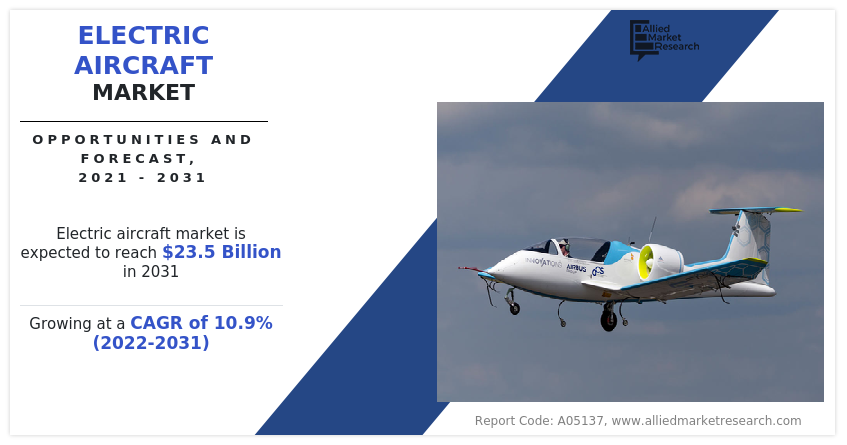
Electric Aircraft Market Key Factors Driving Growth | CAGR 10.9% by 2031

electric aircraft market
Surge in efforts to reduce overall carbon footprint and operational cost of aviation industry drive the growth of the global electric aircraft market
WILMINGTON, NEW CASTLE, DELAWARE, UNITED STATES, April 18, 2024 /EINPresswire.com/ -- According to the report published by Allied Market Research, the global 𝐄𝐥𝐞𝐜𝐭𝐫𝐢𝐜 𝐀𝐢𝐫𝐜𝐫𝐚𝐟𝐭 𝐌𝐚𝐫𝐤𝐞𝐭 has witnessed substantial growth valued at $8.5 billion in 2021, and is anticipated to reach $23.5 billion by 2031, generating a compound annual growth rate of 10.9%, from 2023 to 2032. An electric aircraft is a plane that runs on electricity, usually using one or more electric motors to turn propellers. Batteries are commonly used as the main source of power, although there are other choices. Electrically powered planes have been around since the 1970s, paving the way for the small unmanned aerial vehicles (UAVs) or drones that are commonly used for a variety of purposes today.
𝐑𝐞𝐪𝐮𝐞𝐬𝐭 𝐒𝐚𝐦𝐩𝐥𝐞 𝐏𝐚𝐠𝐞𝐬 𝐍𝐨𝐰: https://www.alliedmarketresearch.com/request-sample/5502
𝐅𝐮𝐭𝐮𝐫𝐢𝐬𝐭𝐢𝐜 𝐓𝐫𝐞𝐧𝐝𝐬 𝐚𝐧𝐝 𝐃𝐞𝐯𝐞𝐥𝐨𝐩𝐦𝐞𝐧𝐭𝐬
The future of the electric aircraft sector looks promising due to continuous investments in R&D, technological progress, and supportive regulatory environments. Electric aircrafts are becoming more viable for extended flights and larger commercial operations, with the improvement of battery technology leading to greater efficiency. Furthermore, advancements in autonomous flight technology and air traffic management systems are expected to be key in promoting the widespread adoption of electric urban air mobility solutions.
𝐏𝐫𝐨𝐦𝐢𝐧𝐞𝐧𝐭 𝐌𝐚𝐫𝐤𝐞𝐭 𝐏𝐥𝐚𝐲𝐞𝐫𝐬
𝐄𝐥𝐛𝐢𝐭 𝐒𝐲𝐬𝐭𝐞𝐦𝐬 𝐋𝐭𝐝., 𝐏𝐈𝐏𝐈𝐒𝐓𝐑𝐄𝐋 𝐝.𝐨.𝐨., 𝐙𝐞𝐫𝐨𝐀𝐯𝐢𝐚, 𝐄𝐯𝐢𝐚𝐭𝐢𝐨𝐧, 𝐄𝐦𝐛𝐫𝐚𝐞𝐫 𝐒𝐀, 𝐑𝐨𝐥𝐥𝐬 𝐑𝐨𝐲𝐜𝐞 𝐏𝐥𝐜, 𝐃𝐮𝐱𝐢𝐨𝐧, 𝐀𝐞𝐫𝐨𝐕𝐢𝐫𝐨𝐧𝐦𝐞𝐧𝐭, 𝐈𝐧𝐜., 𝐄𝐇𝐚𝐧𝐠 𝐇𝐨𝐥𝐝𝐢𝐧𝐠𝐬 𝐋𝐭𝐝., 𝐕𝐎𝐋𝐎𝐂𝐎𝐏𝐓𝐄𝐑 𝐆𝐌𝐁𝐇, 𝐀𝐢𝐫𝐛𝐮𝐬, 𝐉𝐨𝐛𝐲 𝐀𝐯𝐢𝐚𝐭𝐢𝐨𝐧, 𝐥𝐢𝐥𝐢𝐮𝐦, 𝐖𝐫𝐢𝐠𝐡𝐭 𝐄𝐥𝐞𝐜𝐭𝐫𝐢𝐜, 𝐈𝐧𝐜., 𝐀𝐦𝐩𝐚𝐢𝐫𝐞 𝐈𝐧𝐜.
𝐑𝐞𝐠𝐢𝐨𝐧𝐚𝐥 𝐀𝐧𝐚𝐥𝐲𝐬𝐢𝐬:
The regional analysis in this industry report covers the industry performance across Asia-Pacific, North America, LAMEA, and Europe. The study of the Asia-Pacific region covers the performance of the sector in China, Japan, India, South Korea, and the Rest of Asia-Pacific. The analysis of North America includes the market in the U.S., Canada, and Mexico. Furthermore, the analysis of the industry in Africa, Latin America, and the Middle East is included in the LAMEA section. The Europe region includes the analysis of the industry in Germany, the UK, France, Italy, and the Rest of Europe.
𝐏𝐫𝐨𝐜𝐮𝐫𝐞 𝐂𝐨𝐦𝐩𝐥𝐞𝐭𝐞 𝐑𝐞𝐬𝐞𝐚𝐫𝐜𝐡 𝐑𝐞𝐩𝐨𝐫𝐭 𝐍𝐨𝐰: https://www.alliedmarketresearch.com/electric-aircraft-market/purchase-options
𝐓𝐡𝐞 𝐞𝐥𝐞𝐜𝐭𝐫𝐢𝐜 𝐚𝐢𝐫𝐜𝐫𝐚𝐟𝐭 𝐦𝐚𝐫𝐤𝐞𝐭'𝐬 𝐞𝐱𝐩𝐚𝐧𝐬𝐢𝐨𝐧 𝐢𝐬 𝐬𝐡𝐚𝐩𝐞𝐝 𝐛𝐲 𝐬𝐞𝐯𝐞𝐫𝐚𝐥 𝐟𝐚𝐜𝐭𝐨𝐫𝐬:
• 𝐓𝐞𝐜𝐡𝐧𝐨𝐥𝐨𝐠𝐢𝐜𝐚𝐥 𝐏𝐫𝐨𝐠𝐫𝐞𝐬𝐬
Ongoing advancements in battery technology, electric motors, and power electronics have significantly improved the efficiency and performance of electric aircraft. Lithium-ion batteries are preferred for electric propulsion due to their high energy density and lightweight properties.
• 𝐂𝐨𝐬𝐭 𝐄𝐟𝐟𝐞𝐜𝐭𝐢𝐯𝐞𝐧𝐞𝐬𝐬
While the initial investment in electric aircraft technology may be more expensive compared to traditional aircraft, the ongoing costs are significantly lower. Electric aircraft systems require fewer maintenance inspections, result in lower fuel expenses, and benefit from reduced energy consumption. As a result, operators achieve substantial cost savings in the long run.
• 𝐄𝐧𝐯𝐢𝐫𝐨𝐧𝐦𝐞𝐧𝐭𝐚𝐥 𝐅𝐚𝐜𝐭𝐨𝐫𝐬
The growing awareness of climate change and the significance of environmental sustainability has increased the demand for transportation solutions that are environment-friendly. Electric aircrafts offer a compelling alternative to fossil fuel-powered planes as they produce no emissions during operation and contribute to reduced noise pollution.
• 𝐆𝐨𝐯𝐞𝐫𝐧𝐦𝐞𝐧𝐭𝐚𝐥 𝐒𝐮𝐩𝐩𝐨𝐫𝐭
Governments and regulatory agencies globally are increasingly supporting initiatives that promote electric aviation. Incentives such as research grants, tax credits, and regulatory exemptions are stimulating investments in the electric aircraft's development and production.
𝐒𝐞𝐠𝐦𝐞𝐧𝐭𝐚𝐭𝐢𝐨𝐧 𝐎𝐯𝐞𝐫𝐯𝐢𝐞𝐰
The electric aircraft market is segmented into takeoff type, component, end use, and platform. By takeoff type, the market is classified into conventional takeoff & landing, short takeoff & landing, and vertical takeoff & landing. Depending on component, it is divided into batteries, electric motors, aerostructures, avionics, and others. According to end use, the market is bifurcated into commercial and military. As per platform, it is categorized into fixed wing and rotary wing.
𝐂𝐨𝐦𝐩𝐞𝐭𝐢𝐭𝐢𝐯𝐞 𝐒𝐜𝐞𝐧𝐚𝐫𝐢𝐨
The competitive analysis includes profiles of key market players along with the strategies they have employed to sustain their position in the market. These strategies include mergers & acquisitions, collaborations, partnerships, and the introduction of new products.
To conclude, the electric aircraft market represents a significant shift in the aviation industry toward cleaner, more sustainable, and efficient air transportation choices. Electric aircrafts have the potential to revolutionize air travel and contribute significantly to building a greener and more sustainable future owing to continuous innovation and collaboration within the sector.
𝐈𝐧𝐭𝐞𝐫𝐞𝐬𝐭𝐞𝐝 𝐭𝐨 𝐏𝐫𝐨𝐜𝐮𝐫𝐞 𝐭𝐡𝐞 𝐑𝐞𝐬𝐞𝐚𝐫𝐜𝐡 𝐑𝐞𝐩𝐨𝐫𝐭? 𝐈𝐧𝐪𝐮𝐢𝐫𝐞 𝐁𝐞𝐟𝐨𝐫𝐞 𝐁𝐮𝐲𝐢𝐧𝐠: https://www.alliedmarketresearch.com/purchase-enquiry/5502
The increase in environmental concerns, technological advancement in batteries and electric propulsion systems, rise in demand for short range regional routes, and surge in efforts to reduce overall carbon footprint and operational cost of aviation industry drive the growth of the global electric aircraft market. However, several challenges such as the requirement of large and bulky batteries to generate required power, the need to charge the aircraft frequently before scheduled flight path, and limited infrastructure capabilities restrict the market growth. Moreover, the rise in efforts by major companies across the globe to develop electric aircraft capabilities, supported by their research and development budgets, is presenting new opportunities in the coming years.
𝐂𝐡𝐞𝐜𝐤 𝐨𝐮𝐭 𝐦𝐨𝐫𝐞 𝐫𝐞𝐥𝐚𝐭𝐞𝐝 𝐬𝐭𝐮𝐝𝐢𝐞𝐬 𝐩𝐮𝐛𝐥𝐢𝐬𝐡𝐞𝐝 𝐛𝐲 𝐀𝐌𝐑 𝐑𝐞𝐬𝐞𝐚𝐫𝐜𝐡:
Aircraft Engines Market - https://www.globenewswire.com/news-release/2022/08/18/2501020/0/en/Aircraft-Engines-Market-to-Generate-158-46-Billion-by-2031-Allied-Market-Research.html
Aviation Analytics Market - https://www.globenewswire.com/en/news-release/2022/05/31/2453540/0/en/Aviation-Analytics-Market-to-Garner-8-21-Billion-by-2030-Allied-Market-Research.html
Aircraft Electrification Market - https://www.globenewswire.com/en/news-release/2023/05/05/2662272/0/en/Aircraft-Electrification-Market-Predicted-to-Reach-21-8-Billion-Globally-by-2032-at-13-5-CAGR-Allied-Market-Research.html
Aircraft Brake System Market - https://www.globenewswire.com/en/news-release/2021/11/22/2338675/0/en/Aircraft-Brake-System-Market-to-Garner-16-95-Billion-in-2030-Allied-Market-Research.html
David Correa
Allied Market Research
+1 5038946022
email us here
Visit us on social media:
Facebook
Twitter
LinkedIn
EIN Presswire does not exercise editorial control over third-party content provided, uploaded, published, or distributed by users of EIN Presswire. We are a distributor, not a publisher, of 3rd party content. Such content may contain the views, opinions, statements, offers, and other material of the respective users, suppliers, participants, or authors.

